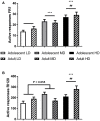Age-Related Differences in Alcohol Intake and Control Over Alcohol Seeking in Rats
- PMID: 30233434
- PMCID: PMC6129585
- DOI: 10.3389/fpsyt.2018.00419
Age-Related Differences in Alcohol Intake and Control Over Alcohol Seeking in Rats
Abstract
Alcohol use disorder (AUD) is characterized by excessive and persistent alcohol use, despite adverse consequences. AUD often originates during adolescence, as do other substance use disorders. However, despite periods of excessive alcohol intake, many adolescents reduce their alcohol use by early adulthood. Brain development, social context, personality traits, and genetic makeup are thought to play an important role in these age-dependent fluctuations in alcohol use. However, studies that directly investigate age-related differences in the effects of alcohol exposure on brain and behavior are sparse. Therefore, to better understand the relationship between adolescent alcohol consumption and AUD-like behavior, this study compared the degree of control over alcohol seeking in rats that differed in terms of age of onset of alcohol drinking and in their level of alcohol consumption. We hypothesized that control over alcohol seeking is more prominent in adolescent-onset rats than in adult-onset rats, and that control over alcohol seeking is related to the consumed amount of alcohol. To test this hypothesis, alcohol seeking in the presence of a conditioned aversive stimulus was assessed after 2 months of intermittent alcohol access (IAA) in rats that consumed alcohol from postnatal day 42 (adolescence) or day 77 (adulthood). The rats were subdivided into low (LD), medium (MD), or high (HD) alcohol drinking rats, in order to assess the impact of the extent of alcohol intake on control over alcohol seeking. The adolescent-onset animals consumed slightly, but significantly less alcohol compared to the adult-onset rats. In adult-onset rats, we found that conditioned suppression of alcohol seeking, i.e., reduction of alcohol seeking by presentation of a conditioned aversive stimulus, was most pronounced in LD. By contrast, in the adolescent-onset rats, MD and HD showed increased alcohol seeking compared to LD, which was suppressed by conditioned aversive stimuli. Taken together, these findings reveal a complex relationship between the age of onset and level of alcohol intake with control over alcohol seeking, whereby adolescent rats consume less alcohol than adults. In adult rats, control over alcohol seeking is negatively related to preceding levels of alcohol intake. By contrast, adolescent rats appear to retain control over alcohol seeking, even after a history of high levels of alcohol intake.
Keywords: addiction-like behavior; adolescence; alcohol; conditioned suppression; individual differences; loss of control; rats.
Figures





Similar articles
-
Individual differences in social play behaviour predict alcohol intake and control over alcohol seeking in rats.Psychopharmacology (Berl). 2021 Nov;238(11):3119-3130. doi: 10.1007/s00213-021-05929-1. Epub 2021 Aug 2. Psychopharmacology (Berl). 2021. PMID: 34338827 Free PMC article.
-
Loss of control over alcohol seeking in rats depends on individual vulnerability and duration of alcohol consumption experience.Behav Pharmacol. 2017 Aug;28(5):334-344. doi: 10.1097/FBP.0000000000000304. Behav Pharmacol. 2017. PMID: 28418943
-
Individual Variation in Alcohol Intake Predicts Reinforcement, Motivation, and Compulsive Alcohol Use in Rats.Alcohol Clin Exp Res. 2015 Dec;39(12):2427-37. doi: 10.1111/acer.12891. Alcohol Clin Exp Res. 2015. PMID: 26745576
-
Adolescent alcohol exposure: Are there separable vulnerable periods within adolescence?Physiol Behav. 2015 Sep 1;148:122-30. doi: 10.1016/j.physbeh.2015.01.027. Epub 2015 Jan 23. Physiol Behav. 2015. PMID: 25624108 Free PMC article. Review.
-
Social consequences of ethanol: Impact of age, stress, and prior history of ethanol exposure.Physiol Behav. 2015 Sep 1;148:145-50. doi: 10.1016/j.physbeh.2014.11.062. Epub 2014 Nov 26. Physiol Behav. 2015. PMID: 25431835 Free PMC article. Review.
Cited by
-
Adolescent ethanol exposure and differential rearing environment affect taste reactivity to ethanol in rats.Alcohol. 2020 Dec;89:113-122. doi: 10.1016/j.alcohol.2020.09.001. Epub 2020 Sep 13. Alcohol. 2020. PMID: 32937167 Free PMC article.
-
Individual differences in social play behaviour predict alcohol intake and control over alcohol seeking in rats.Psychopharmacology (Berl). 2021 Nov;238(11):3119-3130. doi: 10.1007/s00213-021-05929-1. Epub 2021 Aug 2. Psychopharmacology (Berl). 2021. PMID: 34338827 Free PMC article.
-
Experimental Evidence on Age-related Differential Outcomes Associated With Substance Abuse.Basic Clin Neurosci. 2024 Jan-Feb;15(1):27-36. doi: 10.32598/bcn.2023.587.1. Epub 2024 Jan 1. Basic Clin Neurosci. 2024. PMID: 39291086 Free PMC article. Review.
-
Perceived Social Discrimination, Socioeconomic Status, and Alcohol Consumption among Chinese Adults: A Nationally Representative Study.Int J Environ Res Public Health. 2020 Aug 20;17(17):6043. doi: 10.3390/ijerph17176043. Int J Environ Res Public Health. 2020. PMID: 32825210 Free PMC article.
-
Influence of Age and Genetic Background on Ethanol Intake and Behavioral Response Following Ethanol Consumption and During Abstinence in a Model of Alcohol Abuse.Front Behav Neurosci. 2022 Mar 28;16:858940. doi: 10.3389/fnbeh.2022.858940. eCollection 2022. Front Behav Neurosci. 2022. PMID: 35418842 Free PMC article.
References
-
- WHO RE: Global Status Report on Alcohol and Health. World Health Organization; (2011).
-
- American Psychiatric Association Diagnostic and Statistical Manual of Mental Disorders. 5th ed. Washington, DC: American Psychiatric Association; (2013).
LinkOut - more resources
Full Text Sources
Other Literature Sources
Research Materials

